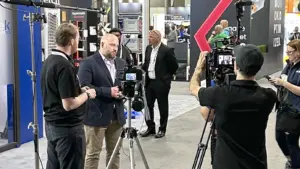Touchscreen kiosks have been making life easier for decades. From the first ATMs to checking in at airports, touchscreens have provided a way for customers to complete transactions without the help of an employee. In the 21st century, touchscreen kiosks are popping up in both new and old venues, continuing to help people do what they need to do faster. This translates to shorter wait times and queuing lines, and overall improved customer experiences. To illustrate how effective this application is, we’re sharing three use cases that demonstrate the benefits of touchscreen kiosks.
Fans Order Food Faster
When grabbing a snack or a beer means diehards are missing potential game-changing moments, long concession lines top the list of complaints by sporting event fans. In fact, some may consider it such a deterrent that they would rather go without than walk away from the action. In 2017, the Philadelphia Phillies’ food service provider, Aramark, provided a solution by introducing touchscreen food ordering kiosks at Citizens Bank Park. According to an article from PHL 17, the self-ordering kiosks allows customers to customize their orders and pay at the kiosk with a credit card.[1] Once the customer pays, they receive a ticket, then pick up their order at a window. Currently, there is a limited menu on the kiosk, but it’s expected to expand. The kiosks not only offer convenience to their fans, but allows the park to reap more revenue by providing an alternative to long queuing lines.
Check In or Out with Ease
The hospitality industry is built on service, but that doesn’t necessarily have to entail human interaction. The Real Self-Service Economy found that 40% of consumers surveyed prefer self-service to human contact.[2] This may be especially true for younger generations that are true digital natives. Good service is much different for these groups versus older generations, as good service to them often means self-service.
Hotels have long had Express Checkout services, but those were just drop boxes for keys. Today, however, touchscreen kiosks are making it easier to both check in and out of hotels. These new self-serve interfaces not only provide key drops, but offer many more convenient services to accommodate lodgers as well. Guests can check in and scan their credit cards for incidentals. Upon checkout, they can review charges to ensure their validity, make payments for remaining balances, and print receipts for accounting purposes.
Healthcare Check-In Improves the Patient Experience
Typically, when you check in to a hospital or for a doctor visit, it requires multiple steps and conversations. In the case of scheduled surgeries or appointments, patients shouldn’t have to deal with the extra stress of wait times and long lines. Because healthcare organizations already have the patient associated data in their systems, some are implementing touchscreen kiosks for registration. In a Health Leaders Media article, they followed the adoption of kiosks at a clinic in Houston. After just one year of use, they found the wait to be 2.44 minutes, which far surpassed the national average of 21.3 minutes.[3] Patient satisfaction can be the difference in ratings and return visits—to ensure satisfaction, hospitals should reduce frustrating wait times with check in kiosks.
These use cases barely skim the surface of the possible applications in which touchscreen kiosks can alleviate wait times and queuing lines. Here at Mimo Monitors, we provide commercial-grade, high quality small touchscreens to improve customer experiences and satisfaction by facilitating convenient, easier interaction in a wide variety of industries. Learn more about our kiosk solutions and how you can use them to improve your processes.
Read more at mimomonitors.com
[1] http://phl17.com/2017/05/11/phillies-debut-new-touchscreen-kiosks-allowing-fans-to-order-food-quickly/
[2] https://www.slideshare.net/stevenvanbelleghem/the-self-serving-economy/11
[3] http://www.healthleadersmedia.com/leadership/patient-check-technologies-cut-cost-wait-times?page=0%2C1#








